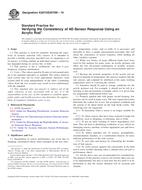Potřebujeme váš souhlas k využití jednotlivých dat, aby se vám mimo jiné mohly ukazovat informace týkající se vašich zájmů. Souhlas udělíte kliknutím na tlačítko „OK“.
ASTM E2075/E2075M-10
Standard Practice for Verifying the Consistency of AE-Sensor Response Using an Acrylic Rod
Automaticky přeložený název:
Standardní praktiky pro ověření souladu AE-Sensor odpovědí pomocí akrylového Rod
NORMA vydána dne 1.6.2010
Informace o normě:
Označení normy: ASTM E2075/E2075M-10
Poznámka: NEPLATNÁ
Datum vydání normy: 1.6.2010
Kód zboží: NS-44206
Počet stran: 4
Přibližná hmotnost: 12 g (0.03 liber)
Země: Americká technická norma
Kategorie: Technické normy ASTM
Anotace textu normy ASTM E2075/E2075M-10 :
Keywords:
acoustic emission sensors, AE, sensor check, sensor consistency check, sensor response, sensor test, sensor verification, Acoustic emission (AE) testing, Acrylic sensor rod, Consistency, ICS Number Code 19.100 (Non-destructive testing)
Doplňující informace
| Significance and Use | ||||||||
|
Degradation in sensor performance can occur due to dropping, mechanical shock while mounted on the test structure, temperature cycles, and so forth. It is necessary and desirable to have a simple measurement procedure that will check the consistency of sensor response, while holding all other variables constant. While test blocks of many different kinds have been used for this purpose for many years, an acrylic polymer rod offers the best all-around combination of suitable acoustic properties, practical convenience, ease of procurement and low cost. Because the acoustic properties of the acrylic rod are known to depend on temperature, this practice requires that the rod, sensors, and couplant be stabilized at the same working temperature, prior to verifying the sensors. Attention should be paid to storage conditions for the acrylic polymer rod. For example, it should not be left in a freezing or hot environment overnight, unless it is given time for temperature stabilization before use. Properly applied and with proper record keeping, this practice can be used in many ways. The user organization must determine the context for its use, the acceptance standards and the actions to be taken based on the lead break results. The following uses are suggested: To determine when a sensor is no longer suitable for use. To check sensors that have been exposed to high-risk conditions, such as dropping, overheating, and so forth. To get an early warning of sensor degradation over time. This can lead to identifying conditions of use, which are damaging sensors, and thus, to better equipment care and lower replacement costs. To obtain matched sets of sensors, preamplifiers, instrumentation channels, or a combination thereof, for more uniform performance of the total system. To save time and money, by eliminating the installation of bad sensors. To verify sensors quickly but consistently in the field and to assist trouble-shooting when a channel does not pass a performance check. All the above uses are recommended for consideration. The purpose of this practice is not to call out how these uses are to be implemented, but only to state how the test itself is to be performed so that the results obtained will be accurate and reliable. |
||||||||
| 1. Scope | ||||||||
|
1.1 This practice is used for routinely checking the sensitivity of acoustic emission (AE) sensors. It is intended to provide a reliable, precisely specified way of comparing a set of sensors, or telling whether an individual sensor's sensitivity has degraded during its service life, or both. 1.2 This practice is not a “calibration” nor does it give frequency response information. 1.3 Units—The values stated in SI units or inch-pound units are to be regarded separately as standard. The values stated in each system may not be exact equivalents; therefore, each system shall be used independently of the other. Combining values from the two systems may result in non-conformance with the standard. 1.4 This standard does not purport to address all of the safety concerns, if any, associated with its use. It is the responsibility of the user of this standard to establish appropriate safety and health practices and determine the applicability of regulatory limitations prior to use. |
||||||||
| 2. Referenced Documents | ||||||||
|




 Cookies
Cookies
